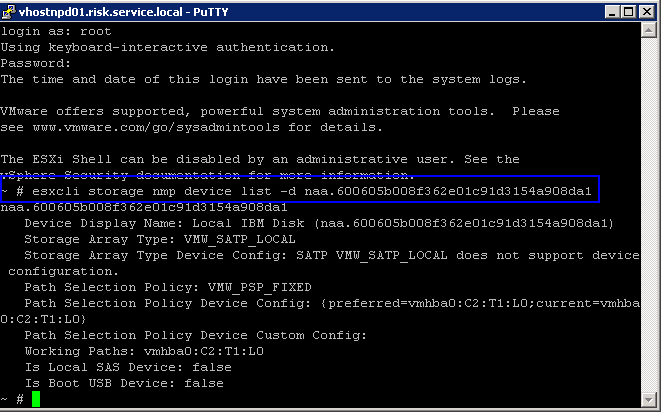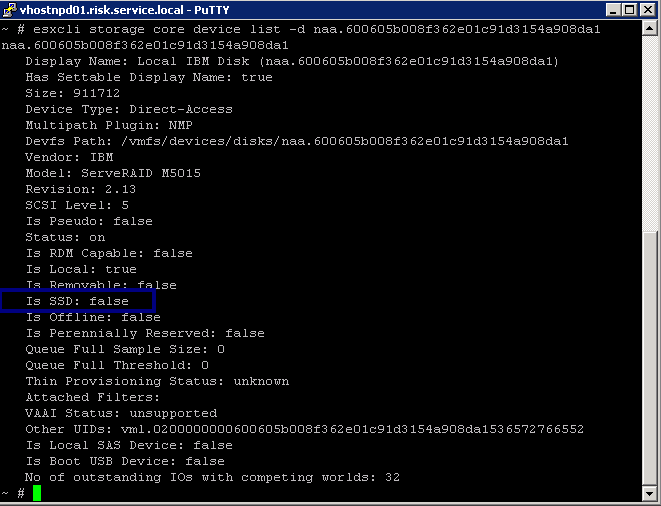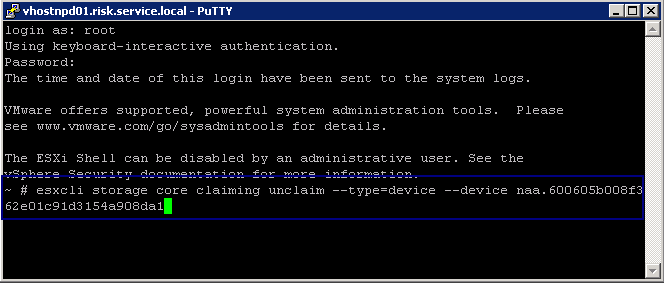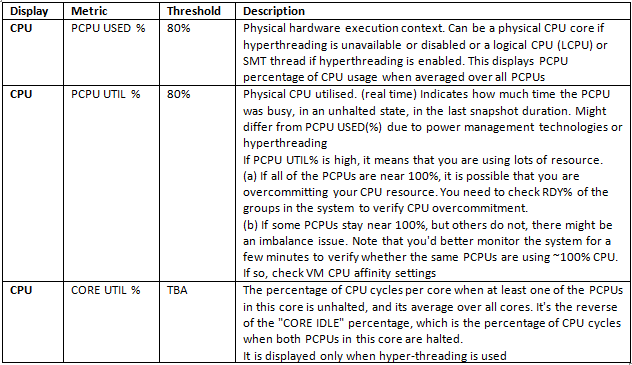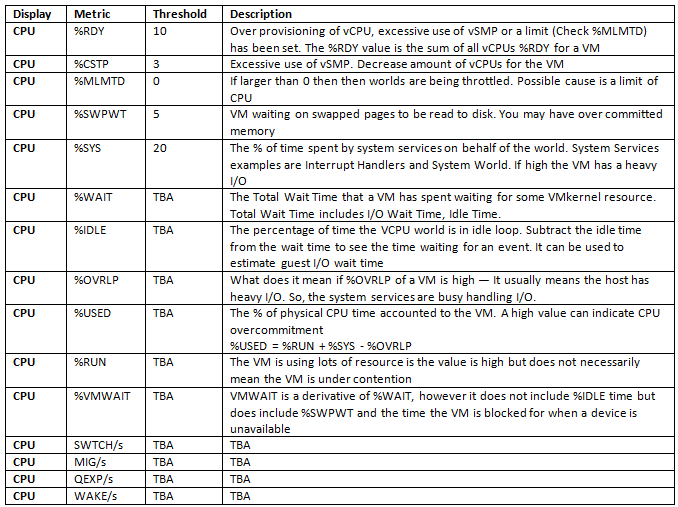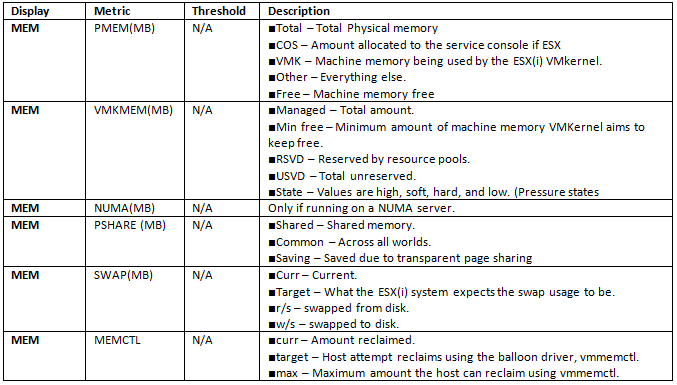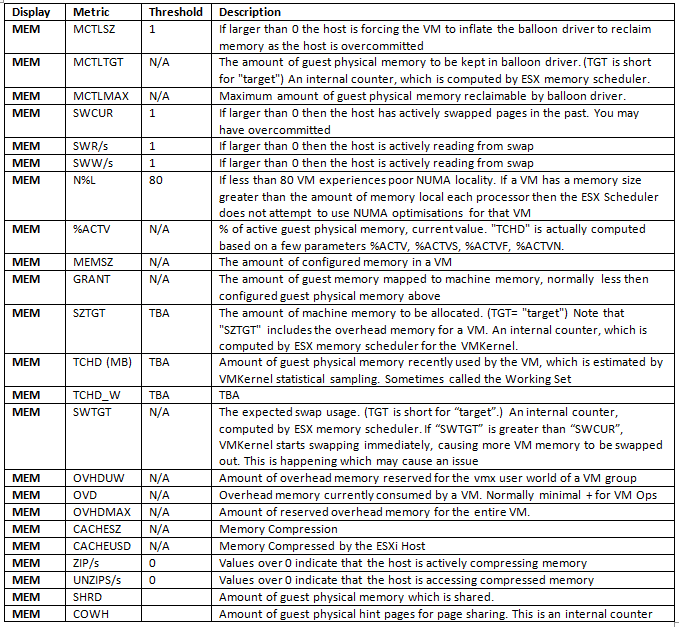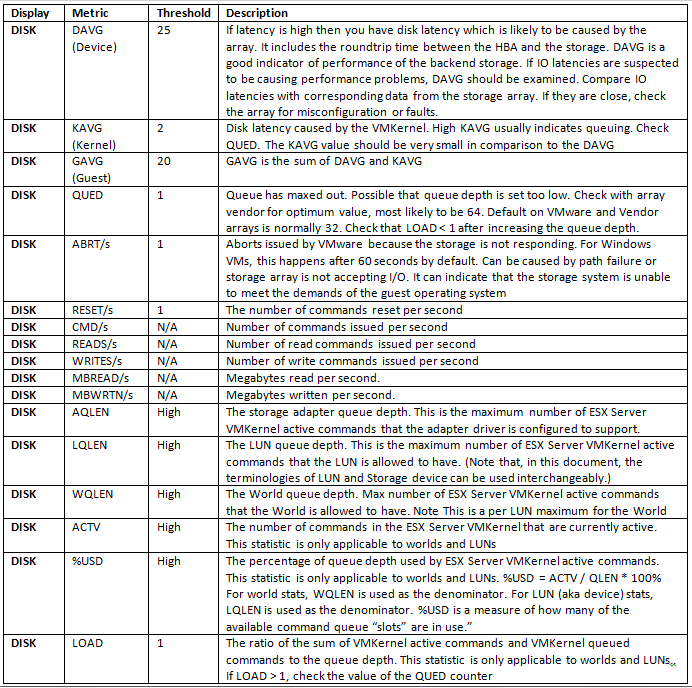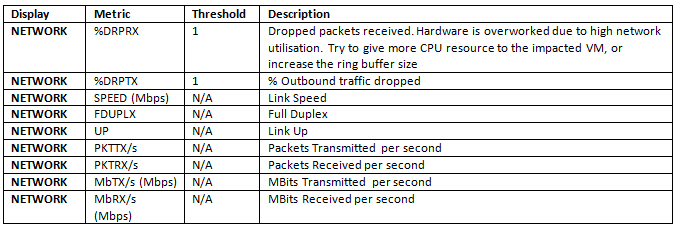| Esxcfg-Commands |
| esxcfg-advcfg |
Set/Get Advance Configuration Parameters (Stored in /etc/vmware/esx.conf) |
| esxcfg-auth |
Configure authentication (ADS, NIS, Kerberos) |
| esxcfg-boot |
Configure Boot-Options |
| esxcfg-configcheck |
Checks format of /etc/vmware/esx.conf (e.g. Used after esx-updates) |
| esxcfg-dumppart |
Configure partition for core-dumps after PSOD |
| esxcfg-firewall |
Configure ESX-server firewall |
| esxcfg-hwiscsi |
Configure hardware iSCSI initiators |
| esxcfg-info |
Get information about hardware, resources, storage, … of the ESX-Server |
| esxcfg-init |
Used Internally on boot |
| esxcfg-linuxnet |
Setup/Remove linux network devices (ethX) |
| esxcfg-module |
Enable/Disable/ Add new/ Query VMKernal modules and set/ get parameters for them. |
| esxcfg-mpath |
Configure multipathing for Fibre-Channel and iSCSI |
| esxcfg-nas |
Configure NFS-datastores (“NFS-client”) |
| esxcfg-nics |
Configure physical nics (VmnicX). |
| esxcfg-pciid |
Recreate PCI-device list /etc/vmware/{pci.ids, pcitable, pcitable.linux, vmware-device.map } from the configuration files /etc/vmware/pciid/*.xml |
| esxcfg-rescan |
Rescan a SCSI/FC/iSCSI adapter. |
| esxcfg-resgrp |
Configure resource groups |
| esxcfg-route |
Configure the VMKernel default route |
| esxcfg-swiscsi |
Configure /Rescan software iSCSI initiator |
| esxcfg-upgrade |
Used for upgrades from ESX2.x to ESX3 |
| esxcfg-vmhbadevs |
Get information about attached LUNs with /dev/sdX/mappings |
| esxcfg-vmknic |
Add /Remove /Configure VMKernel NICs. |
| esxcfg-vswif |
Add/Remove/Configure ServiceConsole NICs |
| esxcfg-vswitch |
Add/Remove/Configure Virtual Switches |
| |
| esx-Commands |
| esxnet-support
|
Diagnostic information about Console NICs (Gives Errors in ESX-3.5.0) |
| esxtop
|
Live Statistics of Virtual Machines (with VM-Names) |
| esxupdate |
Tool for updating ESX-3.x |
| |
| Vmware-Commands |
| Vmware-authd |
For internal use only (authentication) |
| Vmware-cmd |
See vmware-cmd section |
| vmware-configcheck |
Check Virtual Machine configuration files (*.vmx) |
| vmware-config.pl |
Configure ESX-hostd port, recompile/install VMware VmPerl Scripting API |
| vmware-hostd |
Demon for VI Client connections (should only be
started by mgmt-vmware start-script) |
| vmware-hostd-support |
Creates /var/log/vmware/hostd-support.tgz |
| vmware-mkinitrd |
Creates initrd (initial ramdisk) |
| vmware-vim-cmd |
Please see vmware-vim-cmd section |
| vmware-vimdump |
Get information about ESX-Server configuration and Virtual Machines. |
| vmware-vimsh |
Interactive shell – comparable to vmware-vim-cmd with additional commands |
| vmware-watchdog |
Watchdog-Demon to keep vmware-hostd running
(should only be started by mgmt-vmware start-script) |
| vmware-webAccess |
WebAccess-Demon for browser based management (should only be started by
vmware-webAccess start-script) |
| |
| Vm-Commands |
| vmfsqhtool |
Prints UUID of a device header |
| vmfsqueuetool |
Formats all partitions in vmfs queue |
| vmkchdev |
Manage PCI devices (give control over the device to VMKernel or Service Console) |
| vmkdump |
Manage VMKernel dump partition |
| vmkerrcode |
Give description of VMKernel error codes base on decimal or hex value |
| vmkfstools |
Create/Remove/Configure VMFS-Filesystems and Virtual Machine .vdsk files (Virtual Disk File) |
| vmkiscsid |
iSCSI demon |
| vmkiscsi-device |
iSCSI device information |
| vmkiscsi-ls |
List iSCSI devices |
| vmkiscsi-tool |
Configure software iSCSI initiator |
| vmkiscsi-util |
Get information about iSCSI devices |
| vmkloader |
Load and unloads the VMKernel |
| vmkload mod |
Load/Unload VMKernel modules (e.g. device drivers) |
| vmklogger |
Create logmessages (like logger for VMKernel
messages) |
| vmkpcidivy |
deprecated |
| vmkping |
Ping on VMKernel network |
| vmkuptime.pl |
Creates HTML output with Uptime/Downtime/Availability |
| vmres.pl |
deprecated |
| vmsnap all |
Snapshot all Virtual Machines on a ESX-Server |
| vmsnap.pl |
deprecated |
| vmstat |
(this is a standard linux command – lists memory/disk access statistics) |
| vm-support |
Creates /etc/init.d/esx-<date>.tgz |
| vmware |
internal use – can not be started manually |
| |
| Other Commands |
| vdf |
Show free disk space of mounted partitions (like df with vmfs-support) |
| |
| Start-Scripts |
| Scripts inside /etc/init.d/ |
| mgmt-vmware |
Start/Stop/Restart the demon for the VI-Client connections |
| vmkhalt |
internal use – can not be started manually |
| vmware |
internal use – can not be started manually |
| vmware-functions |
internal use – can not be started manually |
| vmware-late |
internal use – can not be started manually |
| vmware-vmkauthd |
internal use – can not be started manually |
| vmware-vpxa |
Start/Stop/Restart the demon for the Virtual Center connections |
| vmware-webAccess |
Start/Stop/Restart the demon for the Web-Interface connections |
| |
| Running Processes |
| crond |
Schedule jobs at specific intervals |
| gpm |
Mouse support in the text console |
| init |
First process which runs every other process |
| klogd |
Kernel log demon |
| logger |
Logs messages to /var/log |
| sshd |
Provides secure shell access |
| syslogd |
Log/Filter demon with a remote logging ability |
| vmware-hostd |
Demon for VI Client connections |
| vmkload app |
Loads vmware applications (internal use only) |
| vmklogger |
Logs VMKernel messages to /var/log/vmware |
|
wsmand |
Web Services Management |
| vmware-vmkauthd |
Demon for user authentication |
| vmware-vmx |
Provides context for a Virtual Machine (internal use only) |
| vmware-watchdog |
Checks if vmware processes are running (no connection test à does not restart hung
processes) |
| vpxa |
Virtual Center agent |
| webAccess |
Web-Interface (TomCat-Server) |
| xinetd |
Listen on network ports for other demons and start them on-demand |
| |
| vmware-cmd Commands |
| Commands for a Virtual Machines (vmware-cmd -h). |
| getconnectedusers |
List name and IP of connected users (non-working with esx3.5.0?) |
| getstate |
Show current state of VM (Ofi/On/…) |
| start |
Start a VM |
| stop |
Stop a VM |
| reset |
Reset a VM |
| suspend |
Suspend a VM |
| setconfig |
Set a variable in the vmx-configuration-file |
| getconfig |
Get a variable from the vmx-file |
| setguestinfo |
Set guest info variable |
| getguestinfo |
Get guest info variable |
| getproductinfo |
Get various product info |
| connectdevice |
Connect a device |
| disconnectdevice |
Disconnect a device |
| getconfigfile |
Get path/filename of config file |
| getheartbeat |
Get current heartbeat |
| gettoolslastactive |
Time since last notification from vmware-tools (in seconds) |
| getresource |
Get a VM resource |
| setresource |
Set a VM resource |
| hassnapshot |
Determine if VM has a snap-shot |
| createsnapshot |
Create a snapshot |
| revertsnapshot |
Revert to last snapshot |
| removesnapshots |
Remove all snapshots |
| answer |
Answer a question (if VM requires input) |
| |
| vmware-vim-cmd Commands |
| hostsvc/ |
ESX-Server commands |
| internalsvc/ |
ESX-Server internal com-
mands |
| proxysvc/ |
Web-SDK proxy commands |
| vimsvc/ |
VirtualCenter commands |
| vmsvc/ |
VM commands |
| |
| Log Files |
| Logs are in /var/log/vmware/ if no other path is specified) |
| /etc/syslog.conf |
Configure logging behaviour |
| esxcfg-boot.log |
Boot messages |
| esxcfg-firewall.log |
List of executed firewall commands and log messages |
| esxcfg-linuxnet.log |
LinuxNet messages |
| esxupdate.log |
Debug messages for updates |
| hostd.log |
hostd messages |
| vpx-iupgrade.log |
Logs for package installations/removals by
Virtual Center (e.g. output of rpm –hiv VMware-vpxa-2.5.0-64192.i386.rpm) |
| vpx/vpxa.log |
Virtual Center Agent messages |
| vmfsqueuetool.log |
VMFSQueueTool messages |
| webAccess |
Web-Access messages |
| /proc/vmware/log |
VMKernel messages |
| /var/log/ storage-Monitor |
VMKernel storage monitor messages |
| /var/log/ vmkernel |
VMKernel messages (info messages only) |
| /var/log/ vmkproxy |
VMKernel userworld proxy messages |
| /var/log/ vmk-summary |
VMKernel messages (notice and higher)
|
| /var/log/ vmk-warning |
VMKernel warning messages |
| |
|

